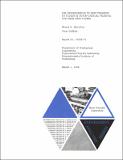The deterioration in heat transfer to fluids at super-critical pressure and high heat fluxes
Author(s)
Shiralkar, B. S.; Griffith, P.
DownloadHTL_TR_1968_051.pdf (3.846Mb)
Other Contributors
Massachusetts Institute of Technology. Dept. of Mechanical Engineering.
Massachusetts Institute of Technology. Division of Sponsored Research.
Massachusetts Institute of Technology. Heat Transfer Laboratory.
Metadata
Show full item recordAbstract
Introduction: Several supercritical steam generators in the American Electric Power system have shown evidence of tube overheat in the lower furnance at the point where the water bulk temperature is about 670 0 F. The evidence is of two kinds. First thermal fatigue has occurred and caused tube failures long before a failure of any kindwas to be expected. Second, pairs of cordal thermocouples have shown very high wall temperatures and, extrapolating back to the inside of the tube, evidence reduced inside heat transfer coefficients. It was suspected that a possible cause of the high tube temperature was a supercritical "burnout". The primary purpose of this investigation is to determine the cause and conditions leading to a supercritical "burnout" such as might occur in a supercritical steam generator. Before focusing on this aspect of the problem it is worthwhile to mention several other possible causes for the high tube wall temperatures which have been observed. In this context high means higher than the design temperature. Let us just list these possibilities. 1. Scale inside the boiler tubes. 2. Hot spot factors in the design procedure which are too low. 3. Higher heat transfer from the combustion gases than expected. Better design procedures or better control of the water purity might be sufficient to cause the problem to disappear without changing the water flow conditions inside the tube. Because the three factors which are listed above are really rather vague, it appeared that the most promising approach is to eliminate the excessive temperatures inside the tube at supercritical pressure is to eliminate the "burnout". Therefore, only the burnout aspect of the problem has been studied here. The undesirable behavior of the Nusselt number, which is of interest, is indicated in Fig. 1. In particular we want to find out when the supercritical Nusselt number is less than one would expect from the affects of simple porperty variations alone.
Date issued
1968Publisher
Cambridge, Mass. : M.I.T. Engineering Projects Laboratory, [1968]
Other identifiers
14135666
Series/Report no.
Technical report (Massachusetts Institute of Technology, Heat Transfer Laboratory) ; no. 51.
Keywords
Heat -- Transmission., Pressure., Thermodynamics.